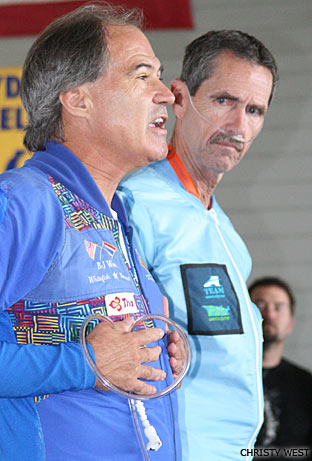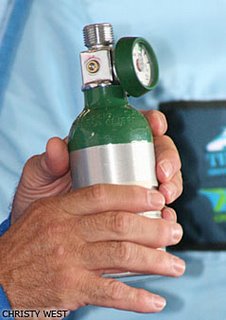World Team Scoop
So here's the scoop on World Team as of today.
- The World Team is going for a new world record of 500 skydivers in formation in January 2011. The event will be held in Thailand again during the Royal Sky Celebration, which will honor His Majesty the King's 84th birthday and him reaching his seventh cycle of 12 years (each cycle is a milestone according to the Buddhist calendar). "This is one of very few places in the world where this can happen," said BJ Worth, referring to the major support of the Royal Thai Air Force for these events.
- In 2010, there will be a smaller event with about half the skydivers (252) held in Thailand as a dry run to familiarize everyone with the new equipment (more on this in a moment), and to see how fast they can build that size formation and extrapolate that to a 500-way build time. "We'll see if we can build it with enough time to do a second point," BJ said amid cheers.
- Kate Cooper-Jensen discussed the skydiver selection process, noting that seniority has little to do with selection for either the 2010 or 2011 events. All interested jumpers will need to fill out a detailed online resume at http://www.theworldteam.com/ (online applications aren't live yet but are expected to be available soon), and list references from World Team sector captains. Once submitted, applications can be updated if significant changes in a jumper's achievements, weight, etc., occur.
- "Currency, competency, and confidence--you need all three in spades whether you're doing a 4-way, 20-way, or World Team," said Kate. She also stressed that World Team members must be team players.
- The base 60-way will practice ahead of time, as the goal is to have a 60-way that consistently builds very quickly and perfectly. "These jumpers won't be the kind of people who 'can only go in the base,' " said Kate. "These will be athletes who can go anywhere in the formation but who are able to use their bodies effectively to give us a good base."
- Members of the alpha team (alternates) are required to have won a medal at a world level competition, as this shows they perform well under pressure.
- The cost of the event hasn't been determined, but it is expected be more expensive than previous events due to inflation and additional equipment (more on this shortly).
When you're jumping from 26,000 feet, you have to have oxygen. And the one downside of the oxygen systems used for these kind of events has always been the brief period off oxygen when the jumpers line up for exit, wait for exit, and freefall down to 15,000 feet (below which supplemental oxygen isn't needed). As oxygen levels in the blood decrease, a number of problems can occur including impaired judgment, blurred vision, headache, nausea, and other issues that can compromise safety.
For the next two World Team events, each jumper will use an auxiliary bailout oxygen system in addition to the aircraft's oxygen system, so they're on oxygen from takeoff to landing (or nearly so). The system starts with a small bailout bottle in a sling around the jumper's neck, which will tuck underneath the jumpsuit. A nasal cannula (one that goes in the nostrils) will be attached to the bottle and during the ride to altitude, it will also be attached to the aircraft's oxygen system. When it's time to line up for exit, jumpers will disconnect their cannulae from the aircraft system and turn on their bailout bottles, which will give them up to 9 minutes of oxygen at a flow rate of 4 liters per minute.
BJ reported testing the system successfully in a barometric pressure chamber with no ill effects. The length of extra oxygen time the bailout bottle provides should even allow one go-around if required (jumpers would hook back into the aircraft's system for a go-around).

BJ Worth discusses the new oxygen system while Larry Henderson demonstrates the system stowed and ready for skydiving.
And Radios for All
"This year every person will have a radio, but not everyone gets a microphone," said BJ amid chuckles. He reported that providing radios for select jumpers worked very well during the last event. "It was one of the very few big records where there was no miscommunication of the exit timing."
For both 2010 and 2011 events, the radios will be used to communicate in-aircraft commands (such as time to get up, turn on bailout bottles, etc.) as well as exit commands to all jumpers. Dirt dive instructions and breakoff timing/communication likely will be assisted by radios as well.
"One idea is that a person sitting on the ground can hear the radio communication of the initial breakoff, and can count down 5 seconds from then, 10 seconds, and so on," explained BJ. "This will give us guidance on real time elapsed," avoiding the shortened counting that often occurs when adrenaline is high.
"We expect 2010 to be a really cool event, and we hope to use the energy and information from that event to set a new world record in 2011," he concluded.
Labels: Thailand, World Team




1 Comments:
Love the new blog.. I'll be watching from work wishing I was there! =D
-Mark K.
Post a Comment
<< Home